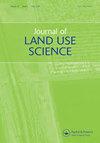Built-up areas are expanding faster than population growth: regional patterns and trajectories in Europe
IF 3.3
4区 环境科学与生态学
Q1 AGRICULTURE, MULTIDISCIPLINARY
引用次数: 8
Abstract
ABSTRACT Human settlements typically expand to accommodate additional housing demand from a growing population and their socio-economic activities. This implies consumption of land, a limited resource necessary for many other services. The efficiency of this exploitation in relation to demographic trends is key to preserve land and natural capital that could otherwise be degraded. Here, we assess patterns of population and built-up area growth over the period 2000–2015, using demographic statistics and remote-sensing data. We find that on average, in the EU27, built-up areas grew at a faster pace than population and that they expanded even in regions where population has declined. We quantify the impact of future population growth under different assumptions on future built-up efficiency. Keeping current built-up per capita fixed could preserve up to 9,000 km2 of land until 2030, especially outside predominantly urban regions, where land use efficiency is generally low and has been declining.建成区的扩张速度快于人口增长:欧洲的区域模式和轨迹
摘要人类住区通常会扩大,以适应不断增长的人口及其社会经济活动对住房的额外需求。这意味着土地的消耗,而土地是许多其他服务所必需的有限资源。这种开采相对于人口趋势的效率是保护土地和自然资本的关键,否则这些土地和自然资源可能会退化。在这里,我们使用人口统计和遥感数据评估了2000-2005年期间的人口和建成区增长模式。我们发现,平均而言,在欧盟27国,建成区的增长速度快于人口,即使在人口下降的地区,建成区也在扩张。我们量化了在不同假设下未来人口增长对未来建成效率的影响。保持目前的人均建成区固定可以在2030年之前保留多达9000平方公里的土地,尤其是在以城市为主的地区以外,那里的土地利用效率普遍较低,而且一直在下降。
本文章由计算机程序翻译,如有差异,请以英文原文为准。
求助全文
约1分钟内获得全文
求助全文
来源期刊

Journal of Land Use Science
Environmental Science-Management, Monitoring, Policy and Law
CiteScore
5.40
自引率
6.20%
发文量
26
期刊介绍:
The Journal of Land Use Science provides a central outlet for high-quality articles on theoretical and empirical aspects of land-use science at the interface of social and environmental systems. The Journal brings together an array of research perspectives at multiple temporal, spatial and social scales that contribute a better understanding of land-system dynamics and communicate scientific advances towards attaining land-system sustainability.
 求助内容:
求助内容: 应助结果提醒方式:
应助结果提醒方式:


